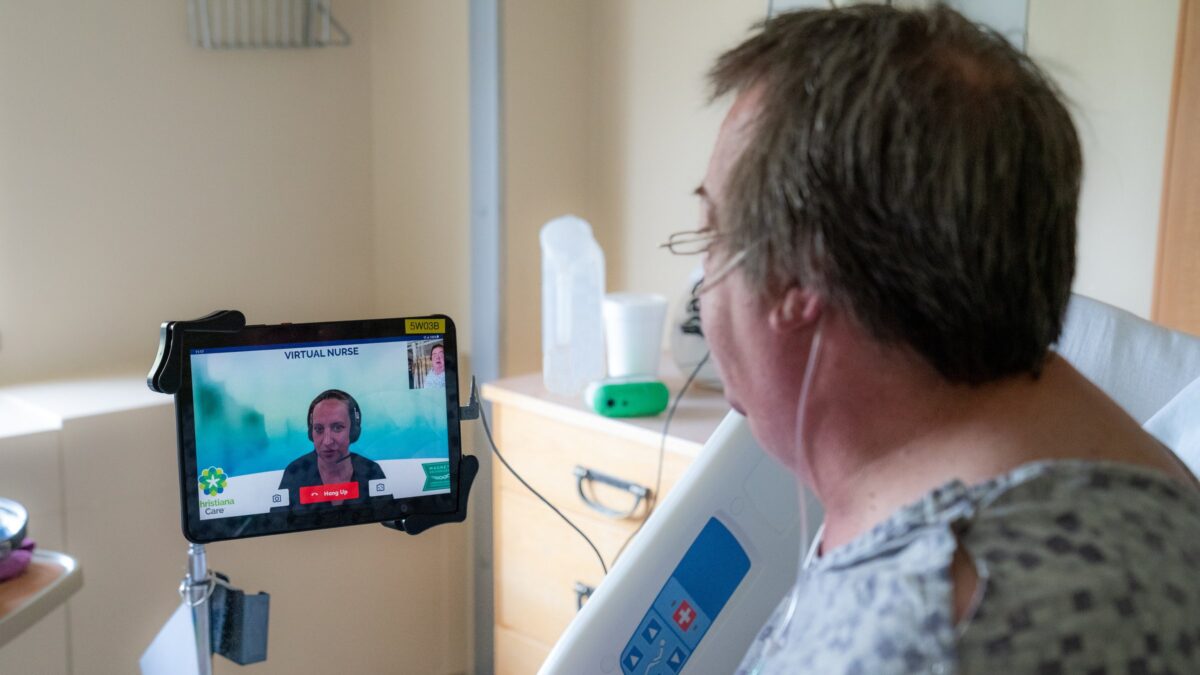How does a healthcare system keep its patients well cared for despite a nursing shortage?
ChristianaCare, like many other healthcare systems across the nation, had to face this question in the last few years, as COVID-19 burnout led to losses of nursing professionals.
A grant from Microsoft and a collaboration with Microsoft AI Cloud partner KiZAN led to ChristianaCare’s co-development of a tech-forward solution for patients at Wilmington Hospital and Christiana Hospital in Newark: virtual acute care nursing.
For people occupying 510 beds in the two hospitals (that’s 41% of all beds), bedside nurses — who have a larger number of patients to care for than would be optimal — are supported by virtual nurses, which are board-licensed registered nurses from within the system who work off-site.
When a patient has a non-emergency issue, like a question about a new prescription or an explanation of treatment to a family member, they can call their virtual nurse using an iPad beside the bed while the in-person nurse tends to other patients.
It’s similar to telemedicine, but for hospital rooms.
Dr. Michelle Collins, the vice president for nursing professional excellence at ChristianaCare, leads the Virtual Acute Care Nursing program. She said that this intervention helps not just the beside nurses, but the patients as well.
“The virtual nurses are providing completion of admissions, medication histories, patient medical education on their disease state and the new medication, their discharge plan, their care coordination for when they go home or to another facility,” Collins told Technical.ly. “In addition to providing clinical documentation burden relief for our clinical nurses who are at the bedside, our virtual nurses have also significantly impacted our patient outcomes.”
Those outcomes include decreases in patients’ length of say, readmission rates and even expected mortality rate, as well as significant improvements in patient experience scores. Having a virtual acute care nurse who can take time to explain medications and a patient’s at-home care plan to both the patients and family members, multiple times if needed, is a factor in the reduction in ChristianaCare’s readmission rate.
“The one-to-one interactions that a virtual nurse has with a patient is uninterrupted care,” said Collins. “So while the clinical nurse may be caring for four or five or six other patients, the virtual nurse cares for one patient at a time.”
The virtual nurse can also call the patient when there’s been an update in their care plan — and if the patient is in the middle of an obligation, the virtual nurse will call back at a better time, so the patient doesn’t have to deal with interruptions.
Collins traced this system’s implementation to Christiana Hospital, Wilmington Hospital, ChristianaCare HomeHealth and ChristianaCare’s Ambulatory Care Services earning a Magnet designation from the American Nurses Credentialing Center, an honor that shows the system’s attention to both patient and nurse satisfaction, back in 2010. The health system also received this designation in 2015 and 2020.
“I think what’s really important to note here is that this is the kind of innovative practice change work that happens as a result of being a Magnet organization,” Collins said. “In order to maintain that designation, you not only need to outperform the national benchmark for patient safety outcomes, patient experience and [registered nurse] satisfaction, but you also need to create the environment where registered nurses can flourish in the nursing practice. And I think this is a phenomenal example of that.”
ChristianaCare nurses, she said, also have had a direct hand in developing the technology.
“They’ve been incredibly insightful,” Collins said. “It’s not a top-down model. It’s a collaborative partnership between nursing leaders and clinical nurses that helps to create an environment that produces the outcomes that we see. That doesn’t happen by accident. It’s purposeful.”







